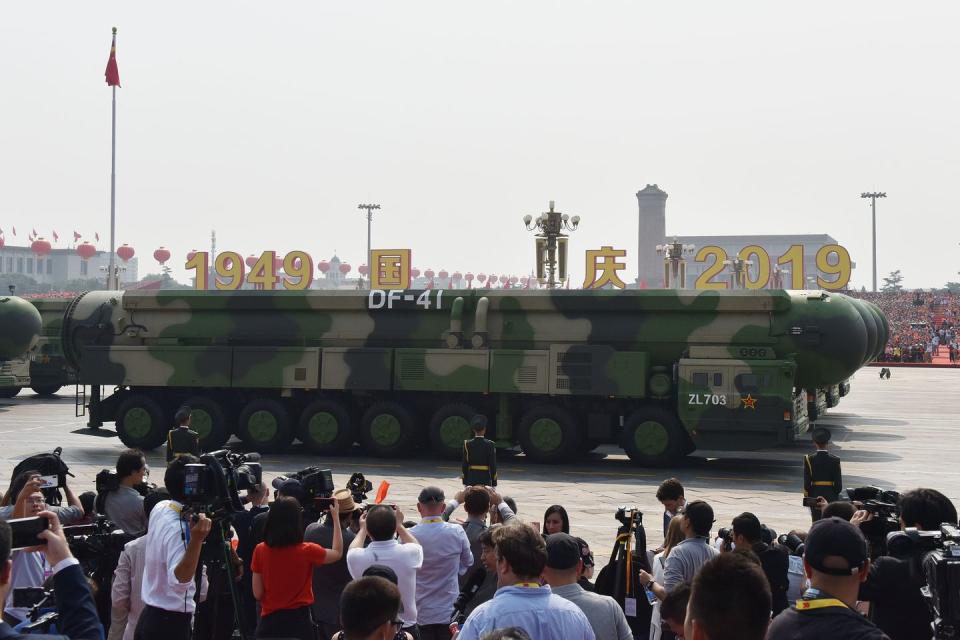China Sure Is Building a Bunch of Nuclear Missile Silos
Analysts have discovered more than 100 new missile silos in China’s northwestern desert region.
The silos are the largest expansion of China’s nuclear weapons program in recent history.
The real question: How many missiles are slated to go into the silos?
Sharp-eyed analysts studying commercial satellite imagery have uncovered 119 nuclear missile silos deep in China’s interior, each capable of storing one intercontinental ballistic missile (ICBM) that can reach the United States. However, nobody knows how many silos will actually shelter live missiles with nuclear warheads.
➡ Read the internet’s most elite military tech content with Pop Mech Pro .
Researchers at the James Martin Center for Nonproliferation Studies in Monterey, California discovered the silos outside the city of Yumen, in China’s northwestern quarter, just west of a wind farm. (Here’s the rough location on Google Maps.) Planet Labs satellites provided the images.
Breaking news: China's building 100+ nuclear missile silos in its desert. In 2020 it was 100+ potential Uighur detention camps, now this.
Great work @ArmsControlWonk @MIIS!@Planet will continue to help journalists find & shed light on key global events.https://t.co/aKYJeIQvpV pic.twitter.com/SVYbj0KsaN— Will Marshall (@Will4Planet) June 30, 2021
Construction has been very quick, according to the satellite images. The entire area was completely undeveloped as recently as January 2021, and a grid of roads suddenly appeared in March. By June, the missile silo locations were clearly marked, and structures are now visible across what was previously a trackless expanse.
China, the fifth country to develop nuclear weapons, now maintains an arsenal of between 250 to 350 nukes. This contrasts to the U.S.’s arsenal of 5,800 weapons, with 1,373 deployed on missiles, bomber bases, or submarines at any one time. Russia, meanwhile, has a total of 6,375 weapons, with 1,326 deployed.
China boasts between 50 and 75 ICBMs and four missile submarines, with a total of eight to nine planned. The country maintains a fleet of 20 nuclear-capable H-6 bombers, but these lack a nuclear gravity bomb. A future bomber, the Xi’an H-20, might eventually be armed with a nuclear bomb and nuclear-tipped cruise missiles.

Most of China’s ICBMs are launched from large transporter-erector-launcher trucks that reportedly shelter in caves. The People’s Liberation Army Rocket Force, the army of the Chinese military that operates its long-range missiles, stores only about 18 to 20 older DF-5 ICBMs in hardened silos. Observers detected another silo field with 16 silos in north central China this past winter.
China has never really concerned itself with large nuclear arsenals or a complicated nuclear strategy, and even has a “no first use” policy when it comes to nukes. The country is seemingly content to own just enough nukes to ensure that at least a small handful survive a first strike, only to emerge and devastate the enemy homeland. That, in China’s mind, is enough to deter adversaries from planning a nuclear first strike on the country, and prevent it from being coerced by another nuclear power.
The new missile field outside Yumen is interesting, but what China does with it remains to be seen. Does it mean China is deploying 119 new DF-41 ICBMs? Maybe. Then again, as the Washington Post points out, China has deployed dummy silos in the past. The real number is almost certainly between one and 119.
Satellite surveillance should allow the U.S. government—and possibly non-governmental analysts—to eventually figure out how many of these silos will store live missiles. It takes several hours to load an ICBM into a silo, and spy satellites could well catch the PLARF in the act. Commercial satellites, which usually capture imagery once a day, might miss the activity.
The silos may also all be connected by a network of tunnels, and the missiles might be loaded below ground. Iran showed off a similar basing strategy in 2020 for missiles carrying conventional warheads. Reloading from an underground tunnel system would make it impossible to know which silos held actual missiles.
Why is China doing this? The country likely believes its nuclear arsenal is no longer large enough to deter its adversaries. The size of U.S.’s nuclear weapons arsenal hasn’t changed in more than a decade. What has changed, however, is America’s ballistic missile defenses, which are slowly growing to include ships and interceptors based in silos. From China’s perspective, it must now have enough nukes to survive a first strike and then penetrate U.S. missile defenses.
Even if it filled all of its silos with ICBMs, China still wouldn’t be powerful enough to launch a surprise attack on the U.S. While such an attack could do substantial damage, it wouldn’t prevent American nuclear forces from launching an even more powerful counterattack. The balance of terror hasn’t changed, and barring a much, much larger expansion, it won’t any time soon.
🎥 Now Watch This:
You Might Also Like

